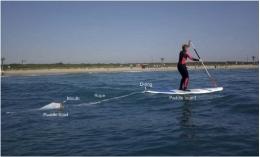Study in Prat and Barceloneta beaches

Credit: Anna Sanchez-Vidal, UNIVERSITY OF BARCELONA
A team of the University of Barcelona has studied for the first time the presence of microplastics in the coasts of Barcelona, thanks to the participation of the citizens gathering scientific samples. The study, published in the journal Science of Total Environment, is a pioneer citizen science study worldwide, since it analyses a hard-access area for oceanography research ships, due its too shallow depth and chance to run aground, and the danger it involves regarding swimmers.
To sample the unexplored area, researchers Elsa Camins, Miquel Canals, William P. de Haan and Anna Sanchez-Vidal, from the consolidated Research Group on Marine Geosciences of the Faculty of Earth Sciences of the UB, in collaboration of the Spanish delegate of the NGO Surfrider Europe, worked on a net which can be dragged by a paddle surfboard. “This net allows us to get valuable scientific samples from an inaccessible area for other kinds of boats, while we involve citizens in this and raise environmental awareness on plastic pollution”, says Anna Sanchez-Vidal.
“Many studies have modelled the abundance and features of microplastics that are adrift in the open sea -continues the researcher- but there was no information on the microplastic pollution in littoral areas, where it is believed there is the largest flow of plastic in the marine environment and where the microplastic generation and overlap of these with marine ecosystems is bigger”.
Study in Prat and Barceloneta beaches
With this lack of data, researchers launched a citizen science project as part of Elsa Camins’ final project of the bachelor’s degree on Marine Sciences. In collaboration with Surfrider Europe, they designed the new net, called paddle trawl, to adapt the net oceanographers usually use in the paddle surf boards. Once it was designed, the NGO volunteers gathered samples in Barceloneta and Prat beaches, and these were later analysed in the laboratories of the UB research group. According to the authors, this study is “a change of paradigm and it opens the door to citizen participation getting samples with a space and time resolution which has not been carried out by any study so far”.
The first results of this collaboration show the areas of the Barcelona coasts have an average microplastic concentration of about 112,000 units per km2, reaching a maximum of 330,000 units per km2 (many are polyethylene and polypropylene fragments), average values similar to those found in the open sea in the Mediterranean or areas of accumulation of microplastics in great ocean gyres. “We think breakwaters can cause a concentrating effect of microplastics in the swimming areas of Barceloneta, but we need studies with a higher time-resolution”, says researcher William P. de Haan.
A growing research project
After the good results obtained with the new sample device, the research team is carrying out a wider study in the Barceloneta beach, where volunteers from the same NGO are gathering samples every 15 days, which are later analysed in the UB. “The objective is to determine the temporary variability in the abundance of microplastics in the coastal area, and therefore the mechanisms of entrance, transport, accumulation and exportation offshore”, says Anna Sanchez-Vidal.
Moreover, together with Surfrider Foundation Europe, they launched a collaboration with the Catalan Association of Oceanic Paddle to get scientific samples not only during their training but also during trips around the Costa Brava and Balearic Islands. “This is a strategy to advance in the scientific knowledge regarding pollution due plastics while it involves citizens and raises environmental awareness on this global crisis”, concludes the researcher.
Pollution due microplastics, the environment and our health in danger
The relevance of microplastics as a key indicator of the environmental state of the oceans is recognized by the Marine Strategy Framework Directive and the UN Program for the Environment and the World Health Organization. Its presence in the planet and its properties of durability (resistance to degradation processes), chemical composition and ability to absorb toxic substances (persistent organic pollutants, metals) make it a dangerous waste. Also, due its small size, microplastics are usually eaten by a great variety of marine organisms, and can expand in the trophic chain and therefore get to humans.
###
Media Contact
Rosa Martínez
[email protected]
0034-934-035-544
Original Source
https:/
Related Journal Article
http://dx.




